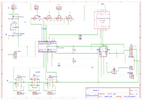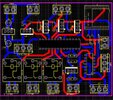Hi everyone,
I'm new in here. I designed a controller card project and the card can switch some devices with relays, dfplayer mini to play sounds from sdcard, external bluetooth music player card is connected to the circuit. cd4066 used for audio switching between dfplayer and Bluetooth audio. But there is noise in audio. 12volt power supply is used with 7805 regulator. Bluetooth Audio and amplifier also uses same power sources from the board. But I have noise in the sound. Can you please review my circuit ?
I'm new in here. I designed a controller card project and the card can switch some devices with relays, dfplayer mini to play sounds from sdcard, external bluetooth music player card is connected to the circuit. cd4066 used for audio switching between dfplayer and Bluetooth audio. But there is noise in audio. 12volt power supply is used with 7805 regulator. Bluetooth Audio and amplifier also uses same power sources from the board. But I have noise in the sound. Can you please review my circuit ?


